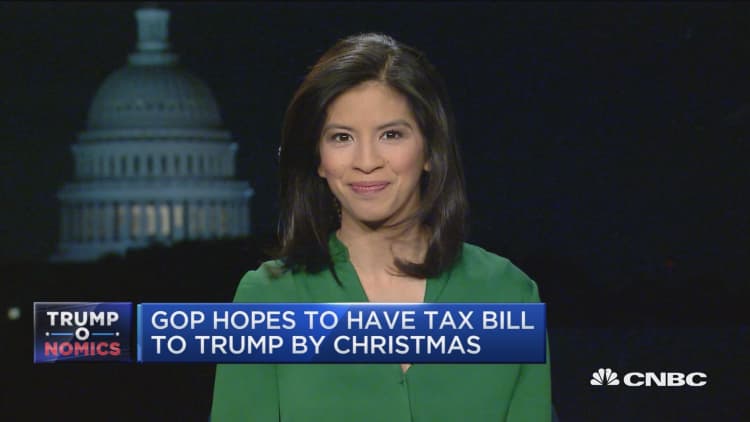Senate Republicans are keeping seven income tax brackets in their tax overhaul, but they are changing the rates that would apply to your income.
Under current law, the seven tax brackets are 10 percent, 15 percent, 25 percent, 28 percent, 33 percent, 35 percent and 39.6 percent.
In the bill passed late Thursday by the Senate Finance Committee, the new rates would be 10 percent, 12 percent, 22 percent, 24 percent, 32 percent, 35 percent and 38.5 percent.
The full Senate is expected to vote on the bill after Thanksgiving.
See below to get a sense of what your bracket will be next year under the proposal.
The Senate brackets
Single payers can expect the following.
| Tax Bracket | Current 2017 Rates | Proposed 2018 Rates |
|---|---|---|
| 10% | 0 to $9,325 | 0 to $9,525 |
| 12% | Not applicable | $9,525 to $38,700 |
| 15% | $9,325 to $37,950 | Not applicable |
| 22% | Not applicable | $38,700 to $70,000 |
| 24% | Not applicable | $70,000 to $160,000 |
| 25% | $37,950 to $91,900 | Not applicable |
| 28% | $91,900 to $191,650 | Not applicable |
| 32% | Not applicable | $160,000 to $200,000 |
| 33% | $191,650 to $416,700 | Not applicable |
| 35% | $416,700 to $418,400 | $200,000 to $500,000 |
| 38.50% | Not applicable | $500,000 and up |
| 39.60% | $418,400 and up | Not applicable |
Married couples who file jointly can expect these brackets.
| Tax Bracket | Current 2017 Rates | Proposed 2018 Rates |
|---|---|---|
| 10% | 0 to $18,650 | 0 to $19,050 |
| 12% | Not applicable | $19,050 to $77,400 |
| 15% | $18,650 to $75,900 | Not applicable |
| 22% | Not applicable | $77,400 to $140,000 |
| 24% | Not applicable | $140,000 to $320,000 |
| 25% | $75,900 to $153,100 | Not applicable |
| 28% | $153,100 to $233,350 | Not applicable |
| 32% | Not applicable | $320,000 to $400,000 |
| 33% | $233,350 to $416,700 | Not applicable |
| 35% | $416,700 to $470,700 | $400,000 to $1 million |
| 38.50% | Not applicable | $1 million and up |
| 39.60% | $470,700 and up | Not applicable |
The House brackets
The House bill differs from the Senate in that it called for a consolidation of the tax brackets, reducing them to four from seven.
That proposal passed the House on Thursday by 227-205.
Here's how your brackets would look under the House overhaul.
Unveiling your new brackets (single filers)
| Tax Bracket | Current 2017 Rates | Proposed 2018 Rates |
|---|---|---|
| 0% | Not applicable | Up to $12,000 |
| 10% | $0 to $9,325 | Not applicable |
| 12% | Not applicable | $12,000 to $45,000 |
| 15% | $9,325 to $37,950 | Not applicable |
| 25% | $37,950 to $91,900 | Beginning at $45,000 |
| 28% | $91,900 to $191,650 | Not applicable |
| 33% | $191,650 to $416,700 | Not applicable |
| 35% | $416,700 to $418,400 | Beginning at $200,000 |
| 39.6% | $418,400 and up | Beginning at $500,000 |
Source: Source: Tax Cuts and Jobs Act
Unveiling your new brackets (married couples)
| Tax Bracket | Current 2017 Rates | Proposed 2018 Rates |
|---|---|---|
| 0% | Not applicable | Up to $24,000 |
| 10% | $0 to $18,650 | Not applicable |
| 12% | Not applicable | $24,000 to $90,000 |
| 15% | $18,650 to $75,900 | Not applicable |
| 25% | $75,900 to $153,100 | Beginning at $90,000 |
| 28% | $153,100 to $233,350 | Not applicable |
| 33% | $233,350 to $416,700 | Not applicable |
| 35% | $416,700 to $470,700 | Beginning at $260,000 |
| 39.6% | $470,700 plus | Beginning at $1,000,000 |
Source: Source: Tax Cuts and Jobs Act
A group of taxpayers currently in the 33 percent bracket would get bumped to 35 percent under the plan. That's because the 35 percent bracket would kick in at lower dollar amounts than the current framework.
WATCH: GOP scores two tax reform victories



